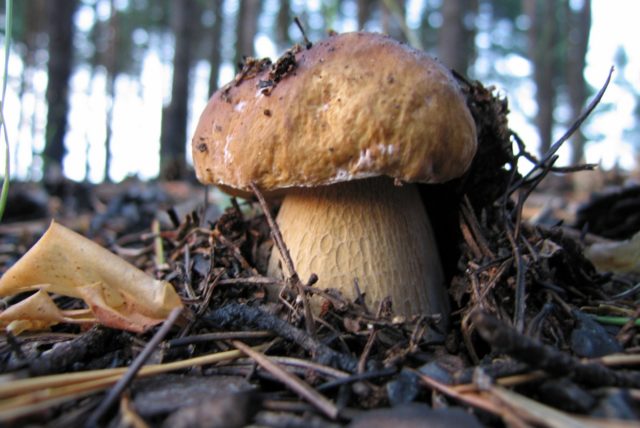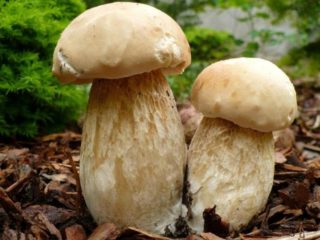Content
- 1 Where do porcini mushrooms grow?
- 2 What do pine boletuses look like?
- 3 Is it possible to eat pine white mushroom?
- 4 Taste qualities of mushrooms
- 5 Benefits and harm to the body
- 6 False doubles of pine porcini mushrooms
- 7 When to collect porcini mushrooms in a pine forest
- 8 How to look for porcini mushrooms in a pine forest
- 9 Rules for collecting porcini mushrooms in a pine forest
- 10 Consumption of pine boletus
- 11 Conclusion
Pine boletus (Bolétus pinóphilus), pine porcini mushroom or boletus mushroom are the names of one species from the Boletus genus. Included in group I in terms of nutritional value, it is used for cooking and winter preparation; if properly processed, it can be consumed raw. The species is considered valuable for its taste and chemical composition.
Where do porcini mushrooms grow?
Pine white boletus is the most common species of its genus. Grows in Europe, America, Spain.In Russia, the main accumulation is observed in regions with a temperate climate. The distribution area is from the Kola Peninsula to the Urals, and is often found in the southern part of Siberia.
Porcini mushrooms grow under perennial pine trees, forming mycorrhiza with the root system of the tree. Less commonly, the species is found under spruce or deciduous trees: oak, hornbeam, chestnut. Prefers sandy soils, moderately moist, and grows on moss or lichen cushions.
It is found in groups, less often singly in areas open to the sun; it is collected in forest clearings, clearings, and on the sides of taiga roads. Fruits from July to the end of September. The main peak in yield occurs during consistently warm weather with sufficient rainfall. Fruiting bodies react poorly to sudden changes in temperature.
What do pine boletuses look like?
The species forms a large fruiting body. The color of the upper part is dark yellow or light brown, shades of red or purple are possible. The color depends on the degree of illumination and the type of tree with which the species is in symbiosis. The lower part of the boletus is white or beige.
In the top photo, the white boletus mushroom grows near pine trees, in the bottom photo it grows in a deciduous forest. This is the same species, but with different colors of the fruiting body.
External characteristics of white pine boletus:
- The shape of the cap is cushion-shaped, at the beginning of the growing season it is spherical, then flatter, hemispherical, with a diameter of 8-30 cm. The protective shell is matte in dry weather, mucous in damp weather.
- The surface is tuberculate or smooth, wrinkled. The color is uneven, the edges of the cap are lighter or white.The protective film is tightly fixed to the surface and is difficult to separate.
- The spore-bearing tubular layer is dense, loose, the pores are small, the tubes are long, white in young mushrooms, yellowish with an olive tint in mature mushrooms. The boundary between the stem and the cap is determined by the depression.
- The leg grows up to 15 cm in length, its diameter is 8-10 cm, a pronounced thickening is visible near the mycelium. The structure is fine-fiber, soft, solid. The surface is mesh, white or light beige, with a pink tint, the color is uniform.
The pulp of the pine boron mushroom is white, thick, dense, and slightly yellowish in overripe specimens. On the cap (near the protective film) with a pink tint. Does not darken on the cut or damaged areas. Retains white color after processing.
Is it possible to eat pine white mushroom?
In terms of taste and chemical composition, pine boletus is classified as an elite species. It is listed in edible group 1 with high nutritional value. Fruit bodies are versatile in processing; they can be used immediately after harvest for preparing all kinds of dishes or processed for winter preparations.
Taste qualities of mushrooms
The pulp of the white boron is thick, dense, and does not lose much weight during processing. The taste is slightly sweet, not very pronounced. The smell of the fruit body is persistent, pleasant, reminiscent of roasted nuts. With any processing method, the smell does not disappear; it is clearly pronounced in dried pine boletuses.
Benefits and harm to the body
The chemical composition of the pine boletus is diverse, the porcini mushroom includes a set of vitamins and microelements necessary for humans, the composition of the protein in the fruiting body is not inferior to animal protein, but the calorie content is much lower.Benefits of pine white boletus for the body:
- Consumption gives a person a feeling of satiety, while minimally supplying the body with calories. It is recommended to include mushroom dishes in the diet of overweight people.
- If a person is on a diet or is a vegetarian, provide the body with enough protein.
- Immunostimulants included in the fruiting bodies strengthen the body, and people are less likely to be affected by infectious diseases.
- Lipids improve the condition of the liver and participate in the regeneration of damaged cells.
- Antibiotic substances in white hogweed inhibit the growth of bacteria.
- Styrene improves the functioning of the endocrine system. Hormonal levels are normalized, reproduction increases, and blood sugar levels decrease.
- Pine boletus is recommended to be included in the diet of people with cardiovascular pathologies. Consumption reduces the level of bad cholesterol, prevents blood clots and atherosclerosis.
- From mycorrhiza with pine, white boletus received a substance presented in the form of a resinous compound capable of removing uric acid from tissues.
- Iron in the fruiting body increases hemoglobin and is involved in hematopoiesis.
- Amino acids and vitamins stimulate brain function, increase performance, and relieve fatigue. Eating pine boletus helps improve sleep and relieves depression.
Even the most valuable species in terms of taste can cause harm to the body. Fruiting bodies accumulate harmful elements if they grow in an unfavorable ecological zone. In this case, porcini mushrooms can cause intoxication.Even harvested in a clean area has a number of contraindications for use. People with an allergic reaction to the product should not even try mushroom dishes. It is undesirable to eat porcini mushrooms if there are metabolic disorders and pathologies of the digestive tract, or with gastritis in the acute stage. Mushroom dishes are contraindicated for pregnant and lactating women, as well as children under 4 years of age.
False doubles of pine porcini mushrooms
Like all elite species, the white pine mushroom has poisonous and conditionally edible counterparts; their photos and descriptions are presented below.
The beautiful or beautiful boletus (Boletus pulcherrimus) looks very similar to the pine-loving boletus.
The double grows in the same conditions as the porcini mushroom, but is distributed throughout forests of all types. Its color is much brighter. The tubular layer is red or crimson, while that of the pine boletus is white or yellow. When scrapped, the pulp turns blue. The species is inedible and contains toxic compounds that cause moderate poisoning.
The pink-purple boletus is a poisonous counterpart, widespread throughout the European part.
Found under beeches, oaks, and hornbeams. Fruit body is smaller. The stem is rounded at the bottom, tapering towards the cap. The tubular layer is bright purple, the surface is pink with a purple tint. When cut, the flesh turns inky.
Wolf boletus is included in the category of conditionally edible species. The fruit body is tasteless and odorless. Consumption is possible only after preliminary boiling. If the heat treatment is short, the double may cause mild poisoning.
Externally, the false species is similar to a pine white mushroom; it has pink spores, the surface of the cap is pale pink. The pulp darkens when scrapped.
This is the main difference between edible and poisonous members of the genus.
When to collect porcini mushrooms in a pine forest
The fruiting period depends on seasonal rains and air temperature. The first fruiting bodies can be found at the end of July; they appear after precipitation in open sunny areas. Pine mushrooms grow quickly, reaching maturity in 5-7 days. They do not grow alone. If one mushroom is found, there will definitely be others nearby. Harvest until the end of September.
How to look for porcini mushrooms in a pine forest
The main accumulation of the species is noted near pine trees, less often the neighbors of boletus are some deciduous trees, beech, birch, and hornbeam. Prefers sandy soils. They are located on moss mats or lichens. You can often see a concentration of the species in clearings among short grass.
Rules for collecting porcini mushrooms in a pine forest
They harvest the harvest after the rains, when the temperature is consistently warm. Pine boletuses are collected only in ecologically clean areas. Forest areas near industrial enterprises and city landfills are not considered. Mushrooms taken near highways and within the city are not suitable for consumption. Mushrooms that are not damaged by insects are cut off and overripe specimens are not taken. Pay attention to the cut; if it has darkened, it is better to get rid of such a specimen.
Consumption of pine boletus
The fruiting bodies are used to prepare a variety of dishes. Pine white boletuses are included in salads in boiled and raw form. Fruit bodies are suitable for winter harvesting; they are dried, pickled, and salted. Pine boletuses tolerate freezing well, completely retaining their beneficial substances.
Conclusion
Pine porcini mushroom belongs to the highest category in terms of nutritional value. Mushrooms are distributed throughout the European part, growing in small groups from June to September. Fruit bodies are universal in use, suitable for all types of processing without prior boiling and soaking. Additionally, you can find out where and how boron white pine mushrooms grow from the video.















